Health Library
Rotator cuff exercises
Shoulder exercises
Images
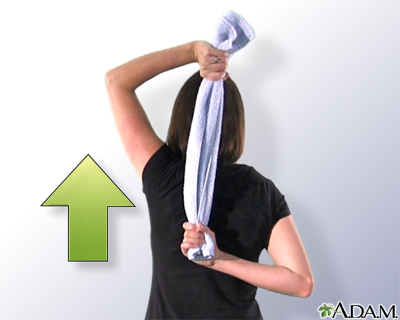
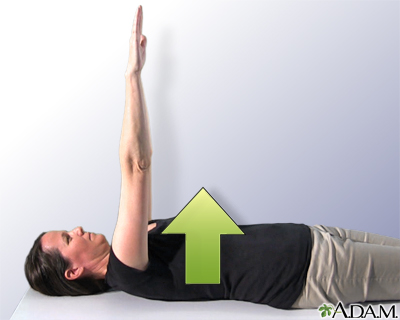

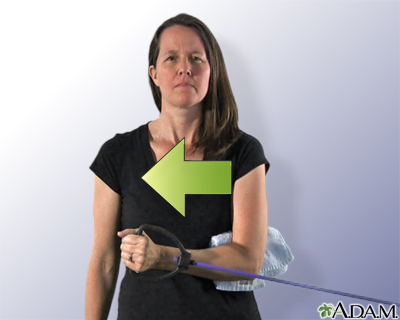
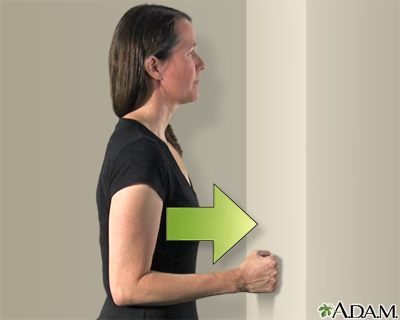


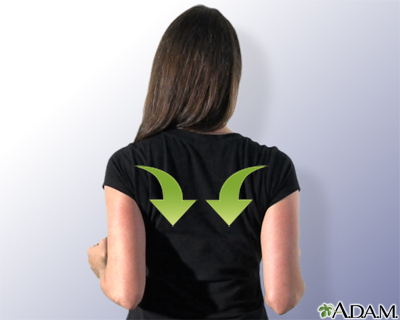

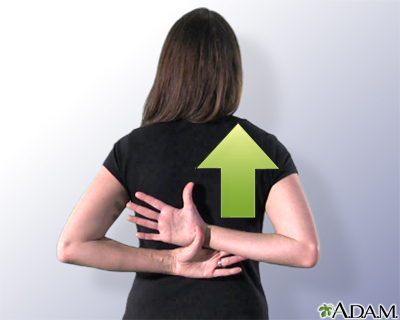


I Would Like to Learn About:
Description
The rotator cuff is a group of muscles and tendons that form a cuff over the shoulder joint. These muscles and tendons hold the arm in its joint and help the shoulder joint to move in a coordinated and pain-free way. The tendons can be torn from overuse, injury, or wearing away over time.
Exercises can help strengthen the rotator cuff muscles and tendons to relieve your symptoms.
Your Shoulder Joint
The tendons of the rotator cuff pass underneath a bony area on their way to attaching to the top of the arm bone. These tendons join together to form a cuff that surrounds the shoulder joint. This helps keep the joint stable and allows the arm bone to move on the shoulder bone.
Injury to these tendons may result in:
- Rotator cuff tendinitis, which is irritation and swelling of these tendons
- A rotator cuff tear, which occurs when one of the tendons is torn due to overuse or injury
These injuries often lead to pain, weakness, and stiffness when you use your shoulder. A key part in your recovery is doing exercises to make the muscles and tendons in your joint stronger and more flexible.
Your health care provider may refer you to a physical therapist to treat your rotator cuff. A physical therapist is trained to help improve your ability to do the activities you want.
Evaluating Your Shoulder
Before treating you, a provider or therapist will evaluate your body mechanics. The therapist may:
- Watch how your shoulder moves as you perform activities, including your shoulder joint and your shoulder blade
- Observe your spine and posture as you stand or sit
- Check the range of motion of your shoulder joint and spine
- Test different muscles for weakness or stiffness
- Check to see which movements seem to cause or worsen your pain
After testing and examining you, your provider or physical therapist will know which muscles are weak or too tight. You will then start a program to stretch your muscles and make them stronger.
Exercises for Your Shoulder
The goal is for you to function as well as possible with little or no pain. To do this, your physical therapist will:
- Help you strengthen and stretch the muscles around your shoulder and shoulder blade to improve shoulder movement
- Teach you proper ways to move your shoulder, for everyday tasks or sports activities
- Teach you correct shoulder posture
Before doing exercises at home, ask your provider or physical therapist to make sure you are doing them properly. If you have pain during or after an exercise, you may need to change the way you are doing the exercise or lower the resistance.
Most exercises for your shoulder either stretch or strengthen the muscles and tendons around your shoulder joint.
Exercises to stretch your shoulder include:
- Stretching the back of your shoulder (posterior stretching)
- Hand up your back stretch (anterior shoulder stretch)
- Anterior shoulder stretch - towel
- Pendulum exercise
- Wall stretches
Exercises to strengthen your shoulder:
- Internal rotation exercise - with band
- External rotation exercise - with band
- Isometric shoulder exercises
- Wall push-ups
- Shoulder blade (scapular) retraction - no tubing
- Shoulder blade (scapular) retraction - tubing
- Arm reach
Related Information
Shoulder arthroscopyRotator cuff problems
Rotator cuff repair
Shoulder pain
Frozen shoulder
Shoulder MRI scan
Shoulder CT scan
Rotator cuff - self-care
Shoulder surgery - discharge
Using your shoulder after surgery
References
Finnoff JT, Johnson W. Upper limb pain and dysfunction. In: Cifu DX, ed. Braddom's Physical Medicine and Rehabilitation. 6th ed. Philadelphia, PA: Elsevier; 2021:chap 35.
Mosich GM, Yamaguchi KT, Petrigliano FA. Rotator cuff and impingement lesions. In: Miller MD, Thompson SR, eds. DeLee, Drez, & Miller's Orthopaedic Sports Medicine. 5th ed. Philadelphia, PA: Elsevier; 2020:chap 47.
BACK TO TOPReview Date: 4/24/2023
Reviewed By: C. Benjamin Ma, MD, Professor, Chief, Sports Medicine and Shoulder Service, UCSF Department of Orthopaedic Surgery, San Francisco, CA. Also reviewed by David C. Dugdale, MD, Medical Director, Brenda Conaway, Editorial Director, and the A.D.A.M. Editorial team.
 | A.D.A.M., Inc. is accredited by URAC, for Health Content Provider (www.urac.org). URAC's accreditation program is an independent audit to verify that A.D.A.M. follows rigorous standards of quality and accountability. A.D.A.M. is among the first to achieve this important distinction for online health information and services. Learn more about A.D.A.M.'s editorial policy, editorial process and privacy policy. A.D.A.M. is also a founding member of Hi-Ethics. This site complies with the HONcode standard for trustworthy health information: verify here. |
The information provided herein should not be used during any medical emergency or for the diagnosis or treatment of any medical condition. A licensed medical professional should be consulted for diagnosis and treatment of any and all medical conditions. Links to other sites are provided for information only -- they do not constitute endorsements of those other sites. No warranty of any kind, either expressed or implied, is made as to the accuracy, reliability, timeliness, or correctness of any translations made by a third-party service of the information provided herein into any other language. © 1997- 2024 A.D.A.M., a business unit of Ebix, Inc. Any duplication or distribution of the information contained herein is strictly prohibited.
